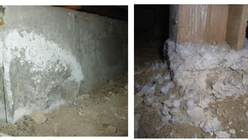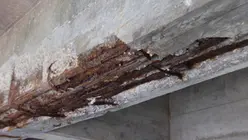Waterproofing Materials

Waterproofing materials are generally materials such as mortar, bitumen/asphalt, cement, which are used to provide impermeability against water and moisture on the horizontal and vertical surfaces of the building that come into contact with water, and materials that are applied to the surface of the building element produced with different components, and waterproofing covers. The whole of the methods developed to protect buildings against water is called “waterproofing system”. waterproofing system; They are drainage systems where water is removed with waterproofing materials using special materials.
Waterproofing Mortars;

In the old times, it was used in adhering coating materials on vertical and horizontal surfaces, as well as ensuring the impermeability of surfaces against water. Impermeability of building element surfaces against water; It was achieved by using mortars and plasters containing different additives such as volcanic ash and pozzolan. For example; Mortars made of lime and sand in ancient times, when applied to soft and porous stone walls; By absorbing the moisture in the mortar by the wall, surface dryness was ensured, and thus the walls remained resistant to moisture for a long time. When more lime and sand were used on the walls, the wall maintained its structural integrity by not losing its load-bearing capacity, even if the humidity level on the wall was high.
Materials such as mortar and plaster used in aqueducts built during the Roman Civilization also provided waterproofing. Similarly, the purpose of the polishing process applied to the surface of the aqueducts is to prevent the shrinkage and cracking of the outer wall layer/surface, and to ensure the flow of water over the surface. In ancient times, the mortar obtained by mixing broken or ground bricks used as aggregate in the production of lime mortar and plaster was called Khorasan in Anatolia, Surkhi in India, and Homra in Arab countries. In Roman architecture, the mixture obtained by adding broken bricks to the mortar of load-bearing walls was called 'cocciopesto'. Cocciopesto mortar was used from the early Hellenistic period to the Ottoman period, especially in the protection of the walls against moisture in structures such as baths, canals and aqueducts.
Bitumen and asphalt;

It is a semi-fluid or solid viscous substance consisting mainly of a complex mixture of hydrocarbons and its derivatives soluble in carbon disulfide. The non-volatile, black colored bitumen softens when heat treated and adheres to the surfaces it is applied to, thus providing insulation against water. Bitumen was used as a mortar on masonry walls in Mesopotamia around 3800 BC; asphalt was used in road construction together with bricks in ancient times. Asphalt, like bitumen, was preferred in ancient times for bonding stone and brick blocks and insulating various architectural structures against water. In the Bronze Age, the Sumerians and Assyrians used bitumen for bonding materials together and for waterproofing wooden columns.
Waterproofing mats;

They are materials in the form of bitumen or synthetic/plastic based cover or sheet used for waterproofing purposes in buildings. In other words, they are bitumen or synthetic based covers that increase the mechanical strength by supporting with different carrier materials. Bitumen-based waterproofing membranes are obtained by covering the lower and upper surfaces of the carrier layer with bitumen homogeneously in the factory environment. The incorporation of different polymers into bitumen by mixing (mechanically) or by chemical reaction is called polymer modification of bitumen.
While bitumen modified with polymer was used only in the roofing industry in the early days of its production, it was later used in the road coating industry. The use of bitumen with atactic polypropylene (APP) was first introduced in Italy in 1965, with applications on roofs. The use of bitumen with styrene butadiene styrene (SBS) started in Europe in the 1970s. Since this date, different bitumen modifications have been made according to different usage purposes by mixing plastomers and thermoplastics with bitumen in Europe and America. Organic (cotton fabrics, jute, animal hair felts, cardboard, etc.) or inorganic (asbestos fiber, glass tulle, glass fabric, polyester felt, metal foil, polyethylene, etc.)
Today, inorganic carriers such as polyester felt, glass tulle or glass woven are mostly preferred, due to the fact that organic materials do not last long against external environmental conditions and cannot meet the expected performance. Adhesion methods of modified bitumen covers; hot welding method (propane torch or hot air), hot asphalt, cold bonding or direct bonding of the material itself.
Developments in synthetic waterproofing membranes date back to the discovery of two discoveries in the chemical modification of natural substances in the 19th century. The first is the vulcanization of rubber discovered by Charles Goodyear in 1839, the second is the nitration of cellulose by Parker in 1862 and cellulose was obtained in 1869. Cellulose is considered to be the first thermoplastic material and is considered to be the ancestor of polymers such as polyvinyl chloride PVC and polyurethane (PU), which are widely used today. This invention, which was found by Goodyear, is still in production, but the concept of 'polymer' had not yet been introduced at the time of its existence. After these developments; The production of thermoplastics such as polyethylene, PVC, polyamide (PA) was carried out between the years 1930-40.
The first production and use of thermoplastics took place in Europe in the first half of the 1960s; It started to be used in North America about 10 years after this date. In the mid-1970s, a mechanical fastening method for PVC sheets on lightweight flat roofs was developed in Europe. While PVC-based covers are applied in Europe without any problems; In the 1980s, it was determined that there were problems in waterproofing made with these covers in North America.
As a result of a research conducted by the National Roofing Contractors Association (NRCA) in 1990, it has been revealed that the thickness of the covers produced according to the European climate is insufficient for the United States. While the use of synthetic-based covers in Europe continues without any problems, although their use is less preferred in the United States, the development of PVC cover technology has been achieved and solutions have begun to be produced for problems, thanks to the fact that some companies continue to produce. Since the first half of the 1990s, PVC-based waterproofing membranes have started to be recycled and reused in Europe after their life cycles have been completed, and in 1999 in the USA.















Comments